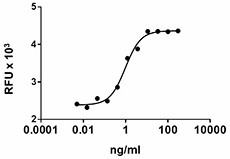- Regulatory Status
- RUO
- Other Names
- IL-13

-

TF-1 cell proliferation induced by recombinant rat IL-13.
| Cat # | Size | Price | Quantity Check Availability | ||
|---|---|---|---|---|---|
| 751702 | 10 µg | $223.00 | |||
| 751704 | 25 µg | $440.00 | |||
| 751708 | 500 µg | $3510.00 | |||
Select size of product is eligible for a 40% discount! Promotion valid until December 31, 2024. Exclusions apply. To view full promotion terms and conditions or to contact your local BioLegend representative to receive a quote, visit our webpage.
Rat IL-13 was initially cloned from the rat renal cortex RNA after the induction of anti-glomerular basement membrane antibody-induced glomerulonephritis. Rat IL-13 respectively shows 63% and 79% homology with the human and mouse proteins at the amino acid level. IL-13 is an immunoregulatory cytokine secreted predominantly by activated Th2 cells, and is a key mediator in the pathogenesis of allergic inflammation. IL-13 shares many functional properties with IL-4, and they share a common receptor subunit: the alpha subunit of the IL-4 receptor (IL-4Rα). IL-13 mediates its effects by interacting with a complex receptor system comprised of IL-4Rα and two IL-13 binding proteins: IL-13Rα1 and IL-13Rα2. The ligation of the IL-13 receptor complex results in signaling via the insulin receptor substrate (IRS)-1 and 2 and STAT-6 pathways. IL-13, like IL-4, is a cytokine produced by Th2 cells in response to the signaling through the T cell antigen receptor and by mast cells and basophils upon cross-linkage of the high-affinity receptor for immunoglobulin E (IgE). IL-13 has been implicated in airway hypersensitivity and mucus hypersecretion, chronic obstructive pulmonary disease (COPD), inflammatory bowel disease, and parasitic nematode expulsion.
Product Details
- Source
- Rat IL-13, amino acids (Thr19 - His131) (Accession# NM_053828), was expressed in E. coli.
- Molecular Mass
- The 113 amino acid recombinant protein has a predicted molecular mass of approximately 12.3 kD. The protein migrates at approximately 9 kD in DTT-reducing and non-reducing conditions by SDS-PAGE. The predicted N-terminal amino acid is Thr.
- Purity
- >95%, as determined by Coomassie stained SDS-PAGE.
- Formulation
- 0.22 µm filtered protein solution is in PBS, pH 7.2
- Endotoxin Level
- Less than 0.01 ng per µg cytokine as determined by the LAL method.
- Concentration
- 10 and 25 µg sizes are bottled at 200 µg/mL. 100 µg size and larger sizes are lot-specific and bottled at the concentration indicated on the vial. To obtain lot-specific concentration and expiration, please enter the lot number in our Certificate of Analysis online tool.
- Storage & Handling
- Unopened vial can be stored between 2°C and 8°C for up to 2 weeks, at -20°C for up to six months, or at -70°C or colder until the expiration date. For maximum results, quick spin vial prior to opening. The protein can be aliquoted and stored at -20°C or colder. Stock solutions can also be prepared at 50 - 100 µg/mL in appropriate sterile buffer, carrier protein such as 0.2 - 1% BSA or HSA can be added when preparing the stock solution. Aliquots can be stored between 2°C and 8°C for up to one week and stored at -20°C or colder for up to 3 months. Avoid repeated freeze/thaw cycles.
- Activity
- ED50 = 0.8 - 5.0 ng/ml, corresponding to a specific activity of 0.2 - 1.25 x 106 units/mg, as determined by the dose dependent stimulation of a TF-1 cell proliferation assay.
- Application
-
Bioassay
- Application Notes
-
BioLegend carrier-free recombinant proteins provided in liquid format are shipped on blue-ice. Our comparison testing data indicates that when handled and stored as recommended, the liquid format has equal or better stability and shelf-life compared to commercially available lyophilized proteins after reconstitution. Our liquid proteins are verified in-house to maintain activity after shipping on blue ice and are backed by our 100% satisfaction guarantee. If you have any concerns, contact us at tech@biolegend.com.
Antigen Details
- Structure
- Cytokine.
- Distribution
-
IL-13 is secreted by activated T cells, Th2 cells, basophils, mast cells, activated eosinophils, natural killer cells (NK), and macrophages.
- Function
- IL-13 modulates human monocytes, macrophages, and B cells. IL-13 induces an increase of MHC class II expression in human monocytes and macrophages, and a direct inhibition of inflammatory cytokines such as TNF-α and IL-1β
- Interaction
- IL-13 receptors are expressed on human B cells, basophils, eosinophils, mast cells, endothelial cells, fibroblasts, monocytes, macrophages, respiratory epithelial cells, and smooth muscle cells.
- Ligand/Receptor
- IL-4α, IL-13Rα1, and IL-13Rα2.
- Biology Area
- Cell Biology, Immunology, Neuroinflammation, Neuroscience
- Molecular Family
- Cytokines/Chemokines
- Antigen References
-
1. Lakkis FG and Cruet EN. 1993. Biochem. Biophys. Res. Commun. 197:612.
2. Papasavvas E, et al. 2005. J. Immunol. 175:5532.
3. Kelly-Welch A, et al. 2005. Sci. STKE. 293:cm8.
4. Hershey GK. 2003. J. Allergy Clin. Immunol. 111:677.
5. Harris J, et al. 2007. Immunity 27:505.
6. LaPorte SL, et al. 2008. Cell 132:259.
7. Brightling CE, et al. 2010. Clin. Exp. Allergy 40:42.
8. De Paiva CS, et al. 2011. Mucosal Immunol. 4:397. - Gene ID
- 116553 View all products for this Gene ID
- UniProt
- View information about IL-13 on UniProt.org
